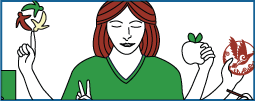
The Anatomy of an Article: Article Writing for the Web
The Anatomy of an Article: Article Writing for the Web
Are you one of those people who hated English classes? Everyone can freeze when it comes time to write articles or content for their website. Here's some hints and tips for writing content that will be read, understood, enjoyed and helpful.
I'm a writer -- so writing is super easy for me. But I've also spent 2 years homeschooling my teenage son through high school -- and he's had handwriting issues since kindergarten. For 7 years, he had been pulled out of class for handwriting work before they gave him something to type on instead. His reluctance to write at all becomes torture for all involved, punctuated in his report cards, and complained about at school meetings ad infinitum. So as a highschool-age homeschooler, it was time to come up with a way to help him write essays in a way he can digest.
Speaking of digesting, this boy loves food. And above all else, sandwiches. If I want to speak his language, I have to talk to him in terms of a sandwich. So I make essays into sandwiches. Maybe it will help you too.
What to write?
I guess the first major stumbling block -- the one that leads to staring at a white piece of paper or "Untitled" in your word processor is knowing what to write, or how to write it. This part should be pretty easy: there are three guidelines for web article content that I have for you:
- Picking topics
- I wrote an article on how to use Google's keyword search tool for picking article topics. This will help you both choose topics, and name the article appropriately so that people can find it when they need the information. You don't have to guess -- just start putting key terms for your industry into the Google keyword tool and study the results. Make a list of potential article topics and you can worry about whether or not you're going to write any of them later. The list will be handy, though, because when you're ready to write, you can pick from a list of potential articles to write.
- Relax and just chat
- Thankfully most website articles, and especially blog articles, are informal writing pieces. Unlike a webpage, which is usually objective and clinical, you can get close-up and personal in articles on your website. So it's best to just write what's on your mind without overthinking it, and you can edit the piece to be shorter, longer, or more organized later. You might find that you get so chatty you have written several articles instead of one. If you're a talker, you can get a digital voice recorder and have a chat as if you're talking to a customer, have it transcribed to text (either do it yourself, have someone at your business do it, or use transcription software like Otter.ai, Temi.com or Dragon Dictate) and then polished into an article.
- Keep it brief
- Articles don't have to be long. If you cover too much territory, consider splitting your content into several articles.
The Sandwich Technique
Consider an article as a sandwich. You have a piece of bread on the top and the bottom. In between you have maybe meat, cheese, condiments, lettuce... Let's make a BLT sandwich, nothing fancy. Bacon, Lettuce, Tomato. And let's face it, we should cover them in order of importance. The first three parts should be included throughout the interior of your article, and the last part goes before and after the rest:
Bacon
A BLT isn't a BLT without the bacon. Consider this the basic substance -- the conclusion you want to come to, the big point you want to make. For example: my big point in this article is that writing an article is really easy if you have some steps to follow. I want to develop that point then state it clearly near the end, in plain English. As the writer, you need to have your bacon in mind -- because you wouldn't even think to have a BLT if you didn't have bacon on-hand, right?
Tomato
Why is the tomato in there? It's there for lubrication, to make it juicy and a little sweet. Face it, if you just have lettuce, bacon and bread you're going to need to chug drinks to get it down. You need social lubrication throughout your article -- be homey, chatty, friendly, helpful. Not preachy, dry, lecturing. This is a chance to showcase your personality so people can come to know, like and trust you.
Lettuce
A bacon and tomato sandwich works -- kinda. But even on toast it's missing some crunch and bulk. It's too flat. Raise the bar on your article with examples of how you got into the crunch, share your own struggle with the issue at hand, use some stories to bulk it up. You don't want to add too much lettuce, or you can't find the tomato & bacon anymore -- same thing in the article: you don't want too many long stories or your message will get lost. But stories help illustrate what's going on, can instantly help people see a problem without lengthy explanations and niche terminology, and when you share your mistakes it humanizes you and makes you more humble.
Bread
Of course it's not a sandwich without bread -- toast, roll, hero, pita bread -- doesn't matter, it's all great. The bread holds the sandwich together. It gives it a distinct beginning & end. An open-face sandwich is awkward -- we don't want an open-face BLT! Give us a sandwich we can really hold on to.
The bread is the introduction and the conclusion of the article. You need to ease people into the content, protect their hands from the tomato goo and the bacon grease and the slippery lettuce. You might start with a question: "Are you one of those people who hated English classes?" -- it certainly works as a hook statement. But even without a hook, you still need bread. Make it quick and simple and answer the reader's first and most important question: "How do I know I need this article?"
Assembling your sandwich: Writing order versus reading order
So it's pretty easy to get your parts together, I'd hope. Next you just have to put them all together into an order that makes sense to your reader.
I talk about bread last because you can make a sandwich by cooking the bacon, slicing the tomato, snapping leaves off the lettuce and then getting the bread ready. But then you assemble the sandwich in the correct order - 1 piece of bread, meat, tomato, lettuce, 1 piece of bread. When you write, you may find yourself starting with the bacon (topic or point), and then adding in the social lubricants, and finding the story to help illustrate the problem, then writing the introduction & conclusion paragraphs. Actually, that's how I wrote this article!
The order in which you prepare the parts doesn't matter as much as assembling them in the correct order in the final version. Here's the end order:
- Introducing Bread
- Crunchy Lettuce Stories
- Lubricating Tomato (example: assurances that the solution is easy)
- Substantial Bacon (the point!)
- Concluding Bread
While writing an article doesn't just happen — it does take a little planning and thought — it doesn't have to be difficult. However, articles are very rewarding: you reap the benefits of your articles every day because the article will always be there for your customers, and an informed prospect asks fewer and smarter questions, hires you faster, and is a better customer overall.
Hopefully you can see how this method of thinking about articles can help you make sure that you have all the elements of a good web article or blog article. Worry less about spelling, punctuation or grammar -- start writing with the meat of the article and add in all the other elements until you have a great sandwich -- uh, article -- for your audience.
Your feedback on this article is welcome, please use the form below:
More Articles:








